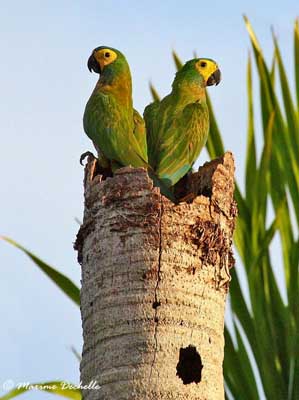
Red-bellied Macaw
Ara manilata
Psittaciforme Order – Psittacidae Family
BIOMETRICS:
Length: 46 à 51 cm
Weight: 290 à 390 g
LONGEVITY : Up to 40 years
DESCRIPTION:
Red-bellied Macaw is a medium-sized Macaw.
Adult male has green plumage on upperparts, including wings and tail. Upperwings show bluish-green flight feathers.
On the underparts, chin, throat and breast show scaly pattern with greyish plumage and green feathers’ edges. It has reddish patch on lower belly and vent. Underwings and undertail are dull olive-yellow.
On the head, cere, lores and face are covered with bare yellow granulous skin. Forecrown is blue-grey, turning dull blue to green on nape.
Strong, hooked bill is blackish. Eyes are dark brown. Legs and feet are grey.
Both sexes are similar.
Juvenile resembles adults, with duller plumage and paler greyish bill with white culmen. Bare face is pale yellowish. It reaches its sexual maturity at two to three years.
Fr: Ara macavouanne
All : Rotbauchara
Esp : Guacamayo Ventrirrojo
Ital : Ara ventrerosso
Nd : Roodbuikara
Photographs by Marc Chrétien
His website: MURINUS
Photographs by Maxime Dechelle
His website: LEPAPARRAZO
Text by Nicole Bouglouan
Sources:
PARROTS OF THE WORLD – An Identification Guide – by Joseph M. Forshaw – Princeton University Press – ISBN 0691092516
HANDBOOK OF THE BIRDS OF THE WORLD vol 4 by Josep del Hoyo-Andrew Elliott-Jordi Sargatal - Lynx Edicions - ISBN: 8487334229
A GUIDE TO THE BIRDS OF COLOMBIA by Steven L. Hilty and William L. Brown - Princeton University Press – ISBN 069108372X
Avibase (Lepage Denis)
Wikipedia (Wikipedia, The Free Encyclopedia)
Arthur Grosset's Birds (Arthur Grosset)

VOICE: SOUNDS BY XENO-CANTO
Red-bellied Macaw gives high-pitched screams. When in flight, it utters wailing “choii-aa” or loud “wrr-rake” and rhythmical “screeet” too. When they are feeding, we can hear kinds of “purring” sounds and several squawks.
HABITAT:
Red-bellied Macaw needs Mauritia palms for nesting and feeding. It is sometimes found in seasonal flooded savannahs with palms and in mangroves.
RANGE:
Red-bellied Macaw lives in Trinidad, Guianas, and E Venezuela to S Colombia, E Ecuador, E Peru, and N Bolivia to Amazonian Brazil. It can be found up to 500 metres of elevation.
BEHAVIOUR:
Red-bellied Macaw is usually resident in its range, but it can perform seasonal movements in some areas.
This bird is noisy and very gregarious, often seen in flocks of up to 100 birds and more. They roost at night in stands of palms where they gather in large flocks.

Red-bellied Macaw feeds among palm fronds where it is almost invisible with its green plumage.
After leaving the roost in the early morning, Red-bellied Macaw’s flocks perch in treetops in nearby trees, in order to perform sunbathing and grooming, while calling. Then, flocks fly to feeding areas.
During breeding season, flocks are smaller. Pairs leave the groups for nesting and communal roosts are less frequented.
Red-bellied Macaw feeds mainly on fruits of Moriche Palm (Mauritia flexuosa). It is a very tall palm tree producing great numbers of fruits, and growing naturally on flooded soils.
FLIGHT:
Red-bellied Macaw performs swift flight with rapid wing beats. It is very conspicuous in flight.

REPRODUCTION:
Breeding season varies, according to the country.
Red-bellied Macaw nests in holes in dead palm trees, often over water, providing to the birds a good protection against predators.
Female lays 2 to 4 white eggs. Incubation lasts about 23 to 26 days.
Young fledge about 73 to 78 days after hatching. These macaws remain in family groups after breeding season, and join again larger flocks for feeding and roosting.
DIET:
Red-bellied Macaw feeds mainly on fruits of Mauritia palms. This fruit grows from December to June. It has reddish colour and shows regular scales, covering a hard nut and rich pulp.

PROTECTION/THREATS/ STATUS:
Red-bellied Macaw populations depend on Mauritia Palms for feeding and nesting. These trees are heavily used for construction, which may have bad consequences for the future of the species.
Red-bellied Macaws are threatened by clearing of these palms and by trapping for pet trade.
However, this species is usually common in most part of its range, except in Colombia, Guyana and Venezuela where it is threatened by habitat loss.
